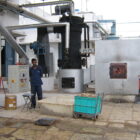Written by Greenboot Energy on Jan 05, 2023.
- Conversion of furnace oil / LDO-fired boiler to briquette-fired system.
In the present era of globalization and neck-to-neck competition, the cost of production plays a vital role. As the price of liquid fuels, especially furnace oil grows at a steeper rate than solid fuel price, substitution of furnace oil to solid briquette is one of the alternatives available. In the war of globalization, only the fittest can survive.
Furnace oil used in a Boiler or Thermic oil heater can be totally substituted by Briquette with an equivalent ratio of 3.0:1 Kg/lit on the basis of calorific value. This usually results in savings of more than 45 to 55 % in operating costs and will have an attractive payback period of 4-6 months at Indian conditions.
- About Briquette and its availability: –
Briquettes are manufactured from Baggase, groundnut shell, saw dust, cotton stalk, corn cobs, and all farm residues, etc. Baggase is a residue of sugar cane after sugar juice extraction and which is available in abundant quantity with sugar mills. The Baggase is dried in the Sunrays or driers and extruded. The compaction gives bulk density up to 1000 Kg/m3to 1100Kg/m3, due to which 10 to25 tons of briquettes can be loaded in single truck.
Being Cellulosic in nature agro-waste briquettes can be easily burnt in boiler without clinker formation.
The contents of the briquette are,( general bio-mass)
Carbon (%) : 40 – 42
Ash (%) : < 10
Hydrogen (%) : 3 – 5
Moisture (%) : less than 5
Other (%)(O2+ N2) : 45
Sulphur (%) : 0
GCV (Kcal/kg) : 4000
- Availability:-
Briquettes are mostly available near sugar factory area, the area where large amount of soybeans are grown or in oil producing area with at low price, while at other places transportation cost will be added. In well-designed furnace other residues (if any) or coal can also be fired if it found economically viable. Firing biomass briquettes in specially design furnace gives many of advantages to nature and economics.
- Economics of Fuel Conversion: –
Briquette has GCV up to 4000Kcal/kg. Our experience has shown that about 3.0 kg of briquette is equivalent to 1 liter of furnace oil. Market price of furnace oil fluctuates so also, the savings. At 40 Rs. / lit F.O. price and briquette at 6.5Rs./kg ( Including the cost of handling and ash disposal) of the substitution will result in savings of 20 Rs/lit. Of F.O. fired.
NB: – You will be eligible for the carbon credit facility.
- Advantages of Briquette firing: –
- Green House Gasses emission reduction,
- No sulphur in flue gases so, maximum waste heat recovery,
- Reduction in NOx level due to low temperature,
- Carbon fixation cycle so, benefit of carbon credits,
- No external adhesive so, eco friendly,
- Saves foreign currency,
- Ash generated is nonhazardous so, used as soil adhesive,
- Rural employment generation helps to stop urbanization, etc.
- Disadvantages of Briquette firing: –
The only disadvantages of switching from liquid to Briquetted fuels are-
- When internal grate furnace is provided then boiler is de-rated by 65%,
- When external furnace is provided then boiler is de-rated by 35%, etc.
- Basic necessity for fuel switch over project: –
Following thing we have to consider for converting the existing boiler from oil to agro waste solid briquette.
- Excess capacity of steam generation with the existing boiler i.e. heat transfer area, as mentioned above.
- Space availability in front of boiler to construct the external furnace and some space to chimney side to install the waste heat recovery unit and ID fan.
- Space for storage of agro waste briquettes @ 30 days consumption.
Note:- This is the general comparison of fuel costs including labor costs and excluding the local and government taxes and duties.






